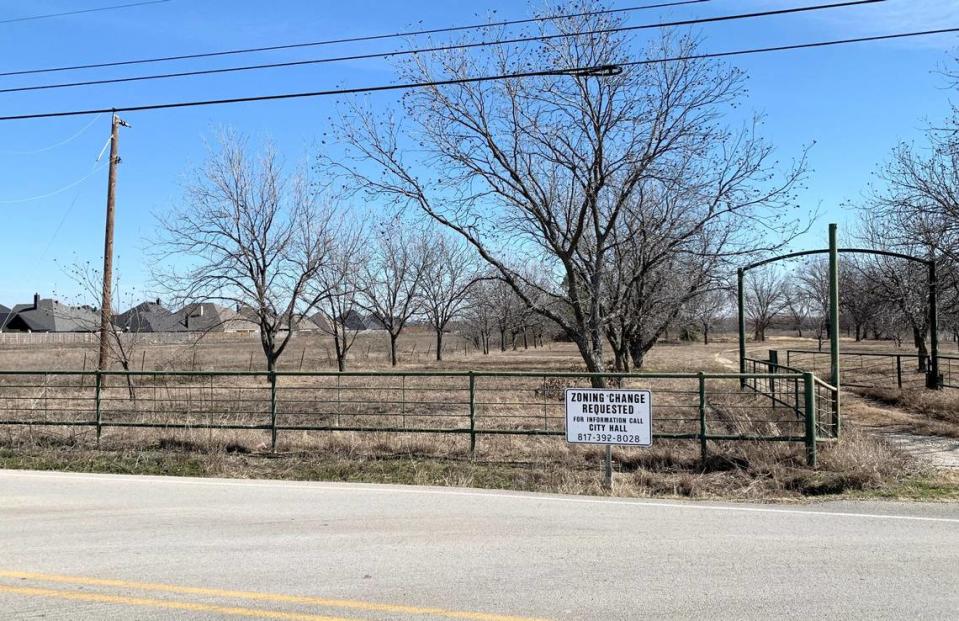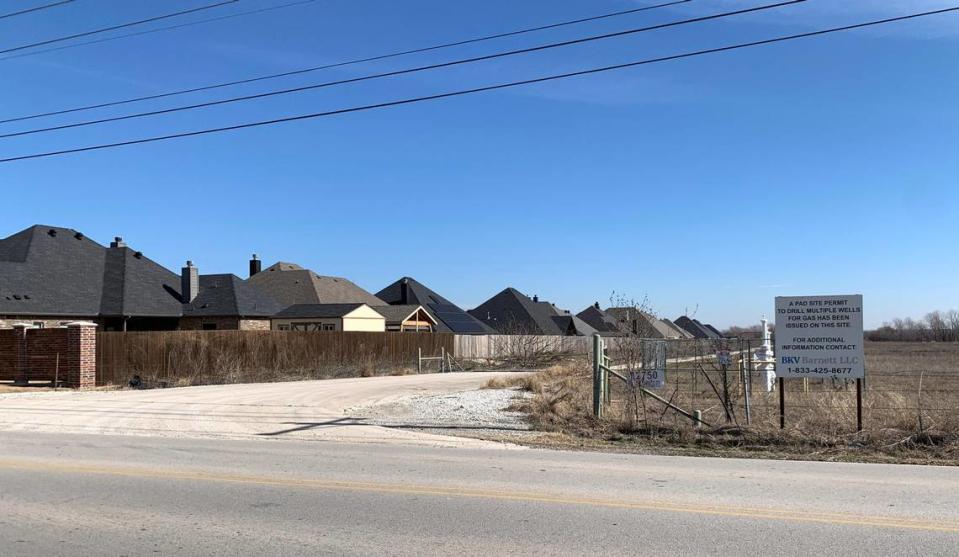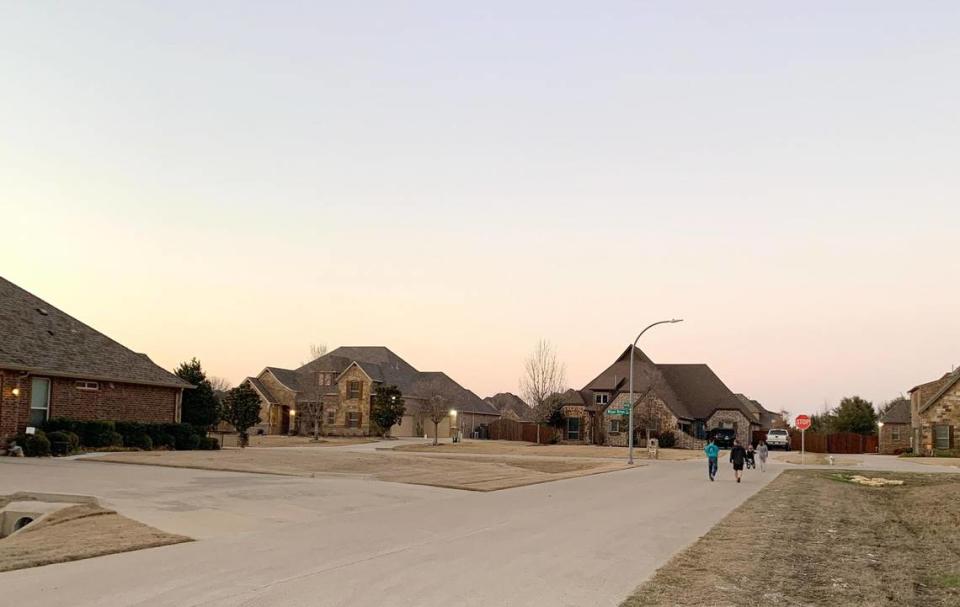Battle over far north Fort Worth housing development lays bare the region’s growing pains
About a mile north of the Blue Mound Road exit on U.S. 287, past a vape shop, empty fields, and an RV storage lot, a yearslong debate over the future of 80 acres of ranch land is reaching a tense crescendo.
Developers hope to convert the bramble and creek of 12650 Willow Springs Road into a 299-unit housing development. Residents of a neighboring subdivision have mobilized to sink the plan, fearing the change would undermine the safety and value of their idyllic enclave.
The Fort Worth City Council will adjudicate the case on Tuesday. The plan’s prospects, and the pushback it generated, lay bare the strains generated by the rapid, relentless expansion of the city’s northern frontier.
‘You can’t stop progress’
About a mile east through the gates of Spring Ranch Estates, past rows of large stone homes with tidy lawns and moat-style drainage ditches, sits Tom Durrant at his kitchen island.
“We all moved out here to live in a semi-country suburb,” he explained on a sunny Monday afternoon. “But you can’t stop …” He lifted his arms above his head and fanned them outwards, gesturing toward the world beyond. “I understand that.”
Fort Worth is one of the fastest growing cities in the nation. Officials estimate that 53 people move to the city every day, many of them crowding in its burgeoning northern suburbs.
The swell has transformed the city’s northern outskirts into a quilt of changing, clashing landscapes. Homes spawn on old farmland at breakneck pace. Sprawling subdivisions are stitched together haphazardly with malls and industrial parks. Cattle still speckle the dwindling number of untouched ranches packed in between.
Durrant and his wife, Pam, bought a home in the Spring Ranch subdivision in 2016. Developers planted the seeds of the community’s first homes in the Northwest school district in the mid-2000s. Around 300 single-family properties, up to two acres in size, have sprouted up since.
The aches of the city’s growth have been difficult to escape. Pam described taking 45 minutes to drive eight miles to her job in the Alliance corridor during rush hour. Semi-trucks and sedans jostle for room on narrow, damaged, unlit country roads. Scheduled improvements to U.S. 287 and Avondale-Haslet Road designed to ease the congestion will take at least four years to complete.
“You can’t stop progress. It’s going to happen,” Pam chimed in, cradling her grandson. “But if they would just be a little more considerate, when they rezone, of how it impacts the community and build the infrastructure first.”

The Villas
A consortium of investors dubbed Haslet Investment LLC purchased the 79.4 acres of land hooking around the southern edge of Spring Ranch in August 2020.
The city had zoned the property for “light industrial” use years earlier. Rick Farnoush, the group’s managing partner, sensed opportunities in other sectors.
Residents of Spring Ranch who communicated with Farnoush when he first purchased the property say he weighed constructing an elderly care facility or an RV park before settling on homes. Farnoush downplayed the seriousness of the other ideas, stating the group’s focus had always been residential.
“We looked at other options, just like any investor looks at other options,” he said.
The group’s housing vision first took the form of “Willow Creek Estates.” A sign for the project still planted on the border of Farnoush’s land and Spring Ranch advertised “1+ acre luxury homesites” starting at $385,000, ready for purchase by Fall 2022.
The city zoning commission greenlighted the group’s efforts to redesignate the land from light industrial to single-family residential in December of that year. But the project never materialized.
The investment team then unveiled “The Villas at Willow Creek” in mid-August 2023. Haslet Investment applied to rezone the land for “low density multifamily” later that month. The “master planned” community promises 299 two and three bedroom homes sized at 1,280 square feet and 1,023 square feet; the development would be embellished with a range of amenities, including playgrounds and pools, according to the site plan.
Whether the homes would be rentals or open for purchase “has not been completely decided yet,” Farnoush said.
Farnoush might sell the land. He has it listed with Dallas-based Onyx Legacy Group as a “build-to-rent community” for $15 million, $12.7 million more than Haslet Investment’s initial acquisition. Some Spring Ranch residents fret the group will offload the property as soon as the zoning change is approved.
Farnoush estimates that rents for the self-described “high-end” homes would range between $2,000 and $3,000 a month; possible purchase prices would be $350,000 to $380,000, he added.
“They’re affordable for this area,” he said.
Fort Worth home and rental prices have soared in tandem with the city’s ballooning population. The city government has described the dearth of affordable housing as a “crisis.” Developers and builders pitch build-to-rent homes as one solution; experts and residents are doubtful.
Homes in Spring Ranch now are listed for upwards of $500,000. A nearby cluster of three bedroom properties off Blue Mound Road, though hundreds of square feet larger than the Villas, are listed for upwards of $400,000.
According to Rentometer, a rental market evaluation tool, the median rent for three-bedroom spaces in 76052 over the past 12 months was $2,095. The median rent for two-bedroom spaces in that time frame was $2,168. Rent.com, a rental listing site, pegs average rents for two bedrooms in far North Fort Worth at $2,340.

The pushback
Spring Ranch residents welcomed the larger, lusher homes Farnoush had originally proposed. The Villas angered and frightened them.
“When you have an established neighborhood and want to encroach that kind of thing on top of us, it’s not right,” Durrant grumbled.
As of Feb. 8, 740 people had signed an petition launched in October urging the city to strike down Haslet Investment’s rezoning proposal. Durrant, the president of his neighborhood’s homeowners association, and other community leaders have lobbied the zoning commission and city council members to scuttle the plan.
A foremost concern is traffic.
The proposed development is bisected into eastern and western pockets by a floodplain. According to the original site plan, prospective Villas residents could only access the eastern half by cutting through two Spring Ranch roads; the development’s western portion would be accessible through Willow Springs Road and another residential street connecting the neighboring subdivisions.
“The addition of 300 new homes, potentially 600 new drivers, sounds overwhelming to our already overwhelmed neighborhood streets,” Chelsea Faxon, a former leader of a Spring Ranch homeowners association, said during a public zoning commission hearing in October.
City Council struck down another housing rezoning proposal about three miles south along Willow Springs Road four years earlier, citing similar traffic concerns.

Farnoush commissioned a traffic study at the behest of Spring Ranch community leaders. The report, finalized Thursday and shared with the Star-Telegram, details a revised road layout for the property: non-emergency traffic would only be able to access the western pod of 143 homes, slated for construction by 2026, through Willow Springs Road; the first 100 homes of the easternmost cluster, scheduled for completion the same year, would only be accessible through a Spring Ranch road until 2028. By then, developers hope to close the Spring Ranch connection and link the eastern portion to Wagley Robertson Road, a street slated to expand and cut through two neighboring developments.
Farnoush acknowledged that the road could take years to complete and that he’s yet to secure the other development’s support for the plan.
The study estimates that the Villas would generate 2,922 weekday trips upon completion, 215 during morning rush hour and 290 as workers return home. Accounting for scheduled road improvements in the area, the study forecasts “acceptable or tolerable” changes in traffic along Wagley Robertson and Willow Springs. To mitigate congestion, engineers recommended widening Blue Mound and Willow Springs Roads and installing turn lanes, among other tweaks.
The fear that an adjacent plot of almost 300 cheaper, smaller homes will sully the value and aesthetic of Spring Ranch properties is also widespread.
“If it gets approved, my value is going to tank,” said Callie Jones, another resident who lives a short golf cart’s drive from Durrant’s home (he sometimes zips around the estate in his EZ Go).
Researchers find little concrete statistical evidence suggesting that more affordable, higher density developments significantly decrease the value of more expensive properties around them. The spiking demand for homes in the area, and a lagging supply of them, would provide extra insulation, Fort Worth real estate agent Chandler Crouch noted.
“Around here, it’s really difficult to find too many horrible examples of something being built and it just cratering property values,” he said.
The resistance mounted by Spring Ranch isn’t new. Eleven years ago, Willow Springs residents hoping to sustain their “semi-rural, semi-suburban” lifestyles fought the conversion of a beloved golf course into housing land.
“We are devastated,” a resident at the time said. “How much we invested, the value of our house, the views, the trees — the whole quality of life there is going to change.”
The fairways spanning once Avondale-Haslet Road have since given way to front lawns.
The future
On Oct. 11, the zoning commission issued a 60-day continuance to give Farnoush and Spring Ranch time to iron out their differences.
Communication between the two parties has been minimal since.
Come December, little had changed. That month, Durrant and his neighbors, all sporting red shirts, pressed zoning commissioners to signal disapproval of the plan, one that city planning staff had originally supported. No one from Haslet Investment showed (only the group’s engineer attended the October meeting). The zoning commission unanimously recommended that city council deny Haslet Investment’s rezoning application without comment.
“The particular part of District 10 is very congested,” Jacob Wurman, the zoning commissioner representing the district, told the Star-Telegram in February. “Having larger trucks with another 300 plus units with no roadway infrastructure made it a less desirable option.”
The City Council will make a final verdict on the case Feb. 13.
“We’re willing to do almost anything to suffice these homeowners,” Farnoush insists.
Spring Ranch residents aren’t optimistic about future compromise.
As frustrations grow, so too does the city.

